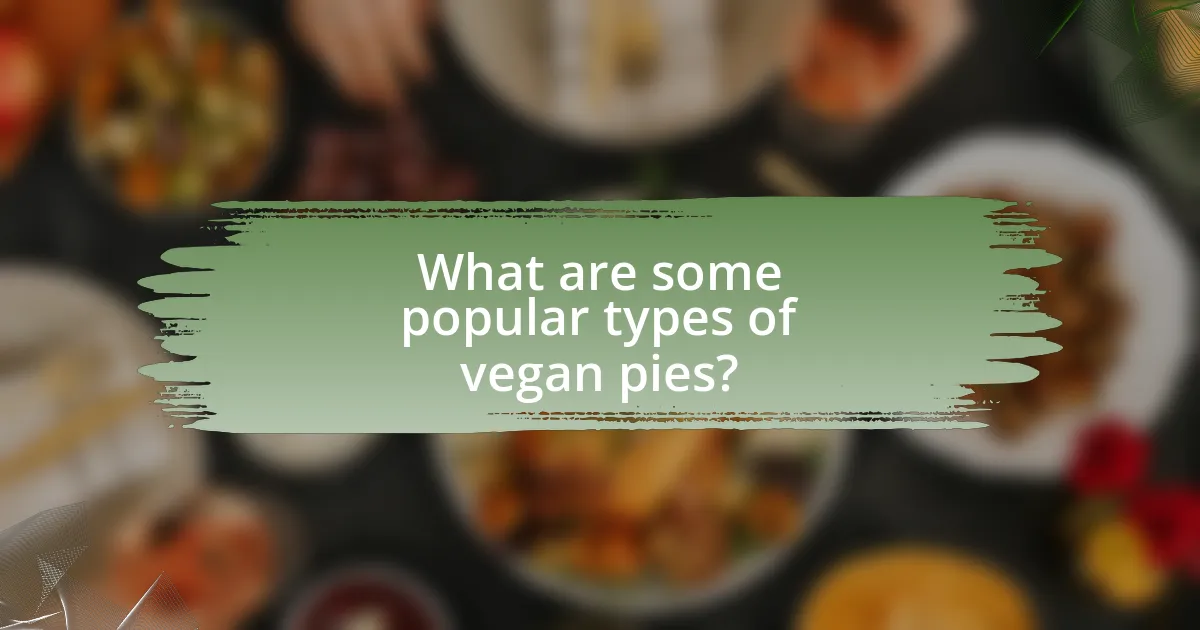Vegan pie recipes offer a variety of flavorful options that do not compromise on taste, utilizing ingredients such as silken tofu, coconut cream, and almond flour. These recipes replace traditional animal products with plant-based alternatives, maintaining rich textures and flavors. Common ingredients include fruits, nuts, and spices, which enhance the overall taste profile while providing nutritional benefits. The article explores popular vegan pie types, techniques for flavor enhancement, and practical tips for creating delicious vegan desserts, demonstrating that plant-based options can be both satisfying and flavorful.

What are Vegan Pie Recipes That Don’t Compromise on Flavor?
Vegan pie recipes that don’t compromise on flavor include options like vegan chocolate silk pie, pumpkin pie made with coconut cream, and berry galette using almond flour crust. These recipes utilize rich ingredients such as silken tofu for creaminess, spices for depth, and natural sweeteners to enhance taste. For instance, the vegan chocolate silk pie combines silken tofu, dark chocolate, and maple syrup, creating a decadent dessert that rivals traditional versions. Similarly, the pumpkin pie recipe incorporates coconut cream and spices like cinnamon and nutmeg, delivering a flavorful experience without dairy. These recipes demonstrate that plant-based ingredients can achieve rich, satisfying flavors in pies.
How do vegan pie recipes differ from traditional pie recipes?
Vegan pie recipes differ from traditional pie recipes primarily by omitting animal products such as eggs and dairy. Instead of these ingredients, vegan recipes utilize plant-based alternatives like flaxseed meal or aquafaba for binding and coconut milk or nut-based creams for richness. This substitution maintains the texture and flavor profile of pies while adhering to a vegan diet. For example, a traditional custard pie relies on eggs for its filling, whereas a vegan custard pie may use silken tofu blended with sweeteners and flavorings to achieve a similar consistency and taste.
What ingredients are commonly used in vegan pie recipes?
Common ingredients in vegan pie recipes include plant-based crusts, fruits, nuts, and dairy alternatives. Plant-based crusts often utilize ingredients like flour, coconut oil, or vegan butter, providing a flaky texture without animal products. Fruits such as apples, berries, and peaches serve as natural sweeteners and flavor enhancers. Nuts, including almonds and cashews, can be used for creaminess or as a topping. Dairy alternatives, like almond milk or coconut cream, replace traditional dairy, ensuring a rich and satisfying filling. These ingredients collectively contribute to the flavor and texture of vegan pies, making them appealing to both vegans and non-vegans alike.
How do these ingredients contribute to flavor in vegan pies?
Vegan pie ingredients contribute to flavor through a combination of natural sweetness, acidity, and umami. For instance, fruits like apples and berries provide sweetness and tartness, enhancing the overall taste profile. Spices such as cinnamon and nutmeg add warmth and depth, while plant-based fats like coconut oil or vegan butter create a rich mouthfeel that complements the flavors. Additionally, ingredients like nutritional yeast can introduce a savory umami note, balancing the sweetness of the pie. These elements work together to create a complex and satisfying flavor experience in vegan pies.
Why choose vegan pie recipes for flavor?
Vegan pie recipes are chosen for flavor because they utilize a diverse range of plant-based ingredients that enhance taste and texture. Ingredients such as fruits, nuts, and spices provide rich flavors, while alternatives like coconut cream and aquafaba can replicate the creaminess and binding properties of dairy and eggs. Studies show that plant-based diets can lead to increased consumption of fruits and vegetables, which are naturally flavorful and nutritious, contributing to the overall taste profile of vegan pies.
What flavor profiles can be achieved with vegan ingredients?
Vegan ingredients can achieve a wide range of flavor profiles, including savory, sweet, umami, and spicy. For instance, ingredients like nutritional yeast and miso can provide umami flavors, while fruits such as berries and citrus can deliver sweetness and acidity. Additionally, spices like cumin and paprika can add depth and warmth, enhancing the overall flavor experience. The versatility of plant-based ingredients allows for creative combinations that can mimic traditional flavors found in non-vegan dishes, making vegan recipes rich and satisfying.
How do spices and herbs enhance the taste of vegan pies?
Spices and herbs enhance the taste of vegan pies by adding depth, complexity, and a variety of flavors that can mimic traditional meat-based dishes. For instance, spices like cumin and smoked paprika can introduce warmth and richness, while herbs such as thyme and rosemary provide aromatic notes that elevate the overall flavor profile. Research indicates that the use of spices and herbs can significantly improve the sensory experience of plant-based foods, making them more appealing to consumers. A study published in the Journal of Food Science found that the incorporation of herbs and spices in vegan recipes can lead to higher satisfaction ratings among tasters, demonstrating their effectiveness in enhancing taste.

What are some popular types of vegan pies?
Popular types of vegan pies include fruit pies, nut pies, and savory pies. Fruit pies, such as apple, cherry, and blueberry, utilize plant-based ingredients like fruits and natural sweeteners. Nut pies, including pecan and almond, often feature a filling made from blended nuts and sweeteners, providing a rich texture. Savory pies, like vegetable pot pie and lentil pie, incorporate a variety of vegetables and legumes, offering hearty and satisfying options. These categories highlight the versatility of vegan pies while ensuring they remain flavorful and appealing.
How can fruit be used in vegan pie recipes?
Fruit can be used in vegan pie recipes as a primary filling, providing natural sweetness and flavor. Common fruits like apples, berries, and peaches can be combined with spices and sweeteners to create a delicious filling that complements the pie crust. For instance, apples can be sliced and mixed with cinnamon and maple syrup, while berries can be mashed and thickened with cornstarch to achieve the desired consistency. This method not only enhances the taste but also ensures that the pie remains plant-based and nutritious.
What are the best fruits for flavor-packed vegan pies?
The best fruits for flavor-packed vegan pies include apples, berries, peaches, and cherries. Apples provide a crisp texture and balance sweetness with tartness, making them ideal for pies. Berries, such as blueberries and raspberries, offer vibrant flavors and natural sweetness, enhancing the overall taste. Peaches contribute a juicy, fragrant quality, while cherries add a rich, tart flavor that complements other ingredients. These fruits are commonly used in vegan pie recipes due to their ability to create a delicious and satisfying dessert without compromising on flavor.
How do different fruits affect the texture and sweetness of the pie?
Different fruits significantly influence the texture and sweetness of a pie. For instance, apples provide a firm texture and moderate sweetness, while berries like blueberries and raspberries contribute a softer texture and higher sweetness due to their natural sugars. Peaches add juiciness and a delicate sweetness, enhancing the overall flavor profile. The pectin content in fruits like apples and pears helps thicken the filling, resulting in a more cohesive texture. In contrast, fruits with higher water content, such as strawberries, can lead to a more liquid filling if not balanced with thickeners. These characteristics are essential for achieving the desired pie consistency and flavor balance.
What are some savory vegan pie options?
Savory vegan pie options include mushroom and spinach pie, lentil shepherd’s pie, and vegetable pot pie. Mushroom and spinach pie combines sautéed mushrooms, fresh spinach, and vegan cheese in a flaky crust, providing a rich umami flavor. Lentil shepherd’s pie features a hearty lentil filling topped with creamy mashed potatoes, making it a comforting dish. Vegetable pot pie is filled with a variety of seasonal vegetables and a savory gravy, encased in a golden crust, offering a satisfying meal. These options showcase the versatility of vegan ingredients while delivering robust flavors.
How can vegetables be incorporated into vegan pies?
Vegetables can be incorporated into vegan pies by using them as the primary filling, either cooked or raw, depending on the desired texture and flavor. Common vegetables such as spinach, mushrooms, zucchini, and sweet potatoes can be sautéed or roasted to enhance their taste before adding them to the pie. For example, a mixture of sautéed onions, garlic, and bell peppers can create a savory base, while roasted butternut squash can add natural sweetness. Additionally, vegetables can be blended into a creamy filling using cashews or silken tofu, providing a rich texture without dairy. This method not only boosts the nutritional value of the pie but also ensures a variety of flavors and colors, making the dish visually appealing and satisfying.
What are some popular savory fillings for vegan pies?
Popular savory fillings for vegan pies include lentils, mushrooms, spinach, and chickpeas. Lentils provide a hearty texture and are often combined with spices for flavor. Mushrooms add umami richness, while spinach contributes a nutritious green element. Chickpeas can be seasoned and mashed to create a creamy filling. These ingredients are commonly used in various vegan pie recipes, ensuring robust flavors without animal products.

What techniques can enhance the flavor of vegan pies?
To enhance the flavor of vegan pies, techniques such as using fresh herbs, incorporating spices, and utilizing high-quality plant-based ingredients are effective. Fresh herbs like basil or thyme can add depth, while spices such as cinnamon or nutmeg can elevate sweetness in fruit pies. Additionally, using ingredients like nutritional yeast or miso can introduce umami flavors, making the pie more savory. Studies show that flavor compounds in fresh herbs and spices can significantly impact taste perception, thus improving overall flavor profiles in dishes.
How does the crust impact the overall flavor of vegan pies?
The crust significantly impacts the overall flavor of vegan pies by providing texture and a base for flavor absorption. A well-prepared crust can enhance the pie’s taste by complementing the filling, while a poorly made crust may detract from the overall experience. For instance, using whole grain flours or nut-based crusts can introduce additional flavors and nutrients, making the pie more satisfying. Research indicates that the Maillard reaction, which occurs during baking, contributes to the development of complex flavors in the crust, further enriching the pie’s taste profile.
What are the best methods for making a flavorful vegan pie crust?
The best methods for making a flavorful vegan pie crust include using a combination of whole grain flours, incorporating healthy fats like coconut oil or vegan butter, and adding flavor enhancers such as vanilla extract or spices. Whole grain flours, such as whole wheat or spelt, provide a nutty flavor and added nutrition. Coconut oil or vegan butter contributes richness and a flaky texture, while vanilla extract or spices like cinnamon can elevate the overall taste profile. These ingredients work together to create a pie crust that is both delicious and satisfying, ensuring that the vegan option does not compromise on flavor.
How can different flours affect the taste and texture of the crust?
Different flours significantly influence the taste and texture of the crust in vegan pie recipes. For instance, all-purpose flour creates a balanced texture and neutral flavor, making it versatile for various pie types. In contrast, whole wheat flour adds a nuttier taste and denser texture due to its higher fiber content, which can result in a heartier crust. Gluten-free flours, such as almond or coconut flour, impart distinct flavors and can lead to a crumbly texture, requiring additional binding agents to achieve the desired consistency. Research indicates that the protein content in flour types directly affects gluten formation, which is crucial for the crust’s structure and chewiness. Therefore, selecting the appropriate flour is essential for achieving the desired flavor profile and texture in vegan pie crusts.
What baking tips can improve the flavor of vegan pies?
To improve the flavor of vegan pies, incorporate ingredients like nutritional yeast, spices, and citrus zest. Nutritional yeast adds a savory, umami flavor that enhances the overall taste profile. Spices such as cinnamon, nutmeg, or ginger can elevate sweetness and complexity, making the pie more aromatic and flavorful. Additionally, using citrus zest, like lemon or orange, brightens the flavor and adds a refreshing note. These ingredients are commonly used in vegan baking to create depth and richness, ensuring that the pies are both delicious and satisfying.
How does baking time and temperature influence flavor development?
Baking time and temperature significantly influence flavor development by affecting the Maillard reaction and caramelization processes. The Maillard reaction, which occurs between amino acids and reducing sugars at temperatures above 140°C (284°F), enhances complex flavors and aromas in baked goods. Longer baking times at optimal temperatures allow for more thorough browning, resulting in richer flavors. For example, a pie baked at 180°C (356°F) for 45 minutes will develop more depth in flavor compared to one baked for only 30 minutes. Additionally, caramelization, which begins around 160°C (320°F), contributes sweetness and complexity, further enhancing the overall taste profile of the pie. Thus, both the duration and the heat applied during baking are crucial for achieving the desired flavor in vegan pies.
What are some common mistakes to avoid when baking vegan pies?
Common mistakes to avoid when baking vegan pies include using the wrong type of fat, neglecting to chill the dough, and not properly measuring ingredients. Using coconut oil or vegan butter instead of all-purpose flour can lead to a crust that is too greasy or dense. Chilling the dough for at least 30 minutes helps to prevent shrinkage during baking, ensuring a better texture. Additionally, inaccurate measurements can result in an unbalanced filling or crust, affecting the overall flavor and consistency of the pie. Accurate ingredient ratios are crucial for achieving the desired taste and texture in vegan pies.
What are some practical tips for creating flavorful vegan pies?
To create flavorful vegan pies, focus on using a variety of spices, herbs, and high-quality ingredients. Incorporating spices such as cinnamon, nutmeg, or cardamom can enhance the flavor profile significantly. Additionally, using fresh herbs like basil or thyme can add depth to savory pies. Opt for ripe, seasonal fruits or vegetables to ensure maximum flavor; for instance, using ripe berries or sweet potatoes can elevate the taste.
Moreover, consider adding a splash of citrus juice or zest, which can brighten the overall flavor. Utilizing plant-based alternatives like coconut cream or cashew cream can also enrich the texture and taste of the filling. Finally, ensure the crust is well-seasoned and flaky, as a good crust complements the filling and enhances the overall pie experience.


